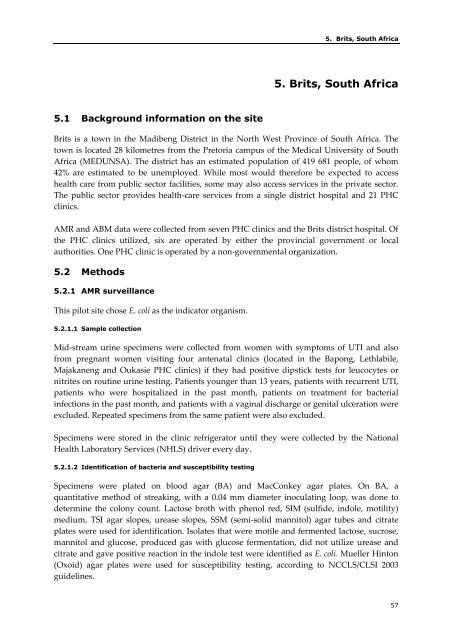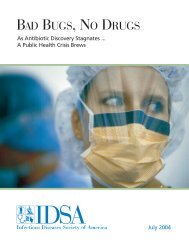Community-Based Surveillance of Antimicrobial Use and ...
Community-Based Surveillance of Antimicrobial Use and ...
Community-Based Surveillance of Antimicrobial Use and ...
- No tags were found...
You also want an ePaper? Increase the reach of your titles
YUMPU automatically turns print PDFs into web optimized ePapers that Google loves.
5. Brits, South Africa5. Brits, South Africa5.1 Background information on the siteBrits is a town in the Madibeng District in the North West Province <strong>of</strong> South Africa. Thetown is located 28 kilometres from the Pretoria campus <strong>of</strong> the Medical University <strong>of</strong> SouthAfrica (MEDUNSA). The district has an estimated population <strong>of</strong> 419 681 people, <strong>of</strong> whom42% are estimated to be unemployed. While most would therefore be expected to accesshealth care from public sector facilities, some may also access services in the private sector.The public sector provides health‐care services from a single district hospital <strong>and</strong> 21 PHCclinics.AMR <strong>and</strong> ABM data were collected from seven PHC clinics <strong>and</strong> the Brits district hospital. Ofthe PHC clinics utilized, six are operated by either the provincial government or localauthorities. One PHC clinic is operated by a non‐governmental organization.5.2 Methods5.2.1 AMR surveillanceThis pilot site chose E. coli as the indicator organism.5.2.1.1 Sample collectionMid‐stream urine specimens were collected from women with symptoms <strong>of</strong> UTI <strong>and</strong> als<strong>of</strong>rom pregnant women visiting four antenatal clinics (located in the Bapong, Lethlabile,Majakaneng <strong>and</strong> Oukasie PHC clinics) if they had positive dipstick tests for leucocytes ornitrites on routine urine testing. Patients younger than 13 years, patients with recurrent UTI,patients who were hospitalized in the past month, patients on treatment for bacterialinfections in the past month, <strong>and</strong> patients with a vaginal discharge or genital ulceration wereexcluded. Repeated specimens from the same patient were also excluded.Specimens were stored in the clinic refrigerator until they were collected by the NationalHealth Laboratory Services (NHLS) driver every day.5.2.1.2 Identification <strong>of</strong> bacteria <strong>and</strong> susceptibility testingSpecimens were plated on blood agar (BA) <strong>and</strong> MacConkey agar plates. On BA, aquantitative method <strong>of</strong> streaking, with a 0.04 mm diameter inoculating loop, was done todetermine the colony count. Lactose broth with phenol red, SIM (sulfide, indole, motility)medium, TSI agar slopes, urease slopes, SSM (semi‐solid mannitol) agar tubes <strong>and</strong> citrateplates were used for identification. Isolates that were motile <strong>and</strong> fermented lactose, sucrose,mannitol <strong>and</strong> glucose, produced gas with glucose fermentation, did not utilize urease <strong>and</strong>citrate <strong>and</strong> gave positive reaction in the indole test were identified as E. coli. Mueller Hinton(Oxoid) agar plates were used for susceptibility testing, according to NCCLS/CLSI 2003guidelines.57




